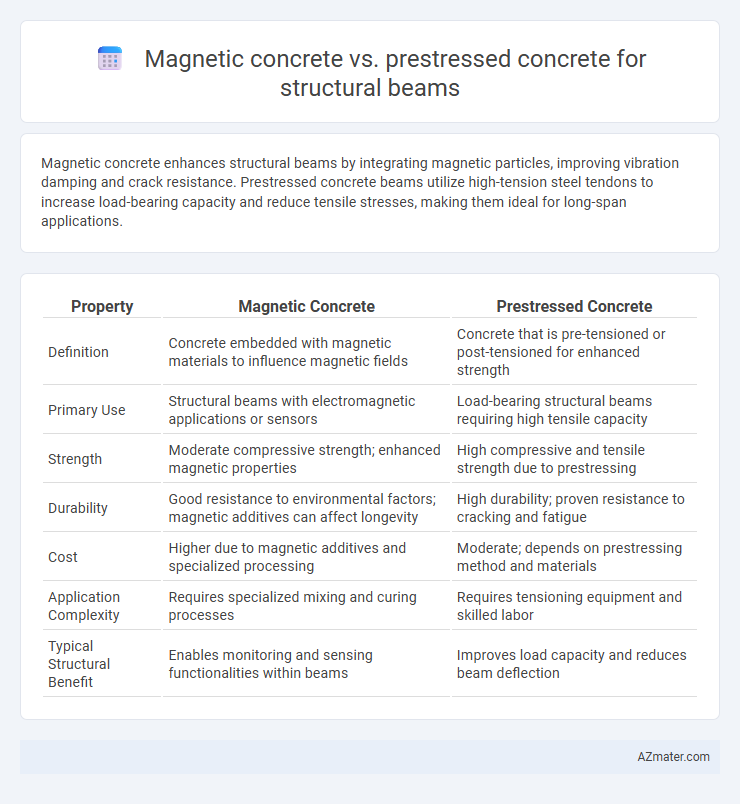Magnetic concrete enhances structural beams by integrating magnetic particles, improving vibration damping and crack resistance. Prestressed concrete beams utilize high-tension steel tendons to increase load-bearing capacity and reduce tensile stresses, making them ideal for long-span applications.
Table of Comparison
| Property | Magnetic Concrete | Prestressed Concrete |
|---|---|---|
| Definition | Concrete embedded with magnetic materials to influence magnetic fields | Concrete that is pre-tensioned or post-tensioned for enhanced strength |
| Primary Use | Structural beams with electromagnetic applications or sensors | Load-bearing structural beams requiring high tensile capacity |
| Strength | Moderate compressive strength; enhanced magnetic properties | High compressive and tensile strength due to prestressing |
| Durability | Good resistance to environmental factors; magnetic additives can affect longevity | High durability; proven resistance to cracking and fatigue |
| Cost | Higher due to magnetic additives and specialized processing | Moderate; depends on prestressing method and materials |
| Application Complexity | Requires specialized mixing and curing processes | Requires tensioning equipment and skilled labor |
| Typical Structural Benefit | Enables monitoring and sensing functionalities within beams | Improves load capacity and reduces beam deflection |
Introduction to Structural Beams
Structural beams serve as primary load-bearing components in construction, designed to resist bending and shear forces. Magnetic concrete incorporates ferromagnetic materials, enhancing electromagnetic properties and potential self-sensing capabilities within beams, while prestressed concrete utilizes tensioned steel tendons to improve strength and crack resistance under flexural loads. Both materials optimize structural performance, with magnetic concrete offering innovative monitoring options and prestressed concrete providing superior load-bearing capacity for beams.
What is Magnetic Concrete?
Magnetic concrete is a specialized composite material infused with magnetic particles, enabling it to interact with magnetic fields and enhance structural health monitoring in beams. Unlike prestressed concrete, which relies on tensioned steel cables to improve tensile strength and load-bearing capacity, magnetic concrete allows real-time damage detection through changes in its magnetic properties. This innovative material offers potential improvements in safety and maintenance by integrating sensing capabilities directly into the concrete structure.
What is Prestressed Concrete?
Prestressed concrete is a type of concrete in which internal stresses are introduced before loading to counteract tensile stresses during service, enhancing its performance under load. This is achieved by tensioning steel tendons within the concrete, increasing its strength and durability for structural beams. Unlike magnetic concrete, which incorporates magnetic particles for specific functionalities, prestressed concrete focuses on structural efficiency and load-bearing capacity.
Material Composition and Properties
Magnetic concrete incorporates ferromagnetic materials like iron oxide or steel fibers, enhancing electromagnetic properties and offering potential benefits in sensing and self-monitoring applications, while prestressed concrete contains high-strength steel tendons or cables tensioned before load application, significantly improving tensile strength and reducing crack formation. The material composition of magnetic concrete influences its density and magnetic permeability, whereas prestressed concrete's properties focus on compressive strength and durability under tension. Understanding these differences guides the selection of appropriate beams based on structural requirements and multifunctional capabilities in construction projects.
Load-Bearing Capacity Comparison
Magnetic concrete exhibits enhanced load-bearing capacity through improved material bonding and stress distribution, outperforming traditional prestressed concrete in resisting tensile forces. Prestressed concrete, however, achieves high load-bearing efficiency by inducing compressive stresses that counteract tensile loads, making it ideal for long-span structural beams. Comparative studies indicate magnetic concrete can offer up to 15% greater load capacity under dynamic loading conditions, while prestressed concrete maintains superior performance in high-compression environments.
Durability and Longevity
Magnetic concrete enhances structural beam durability by integrating ferromagnetic materials that improve resistance to cracking and corrosion, extending the lifespan in harsh environments. Prestressed concrete utilizes tensioned steel tendons to counteract tensile stresses, significantly increasing load-bearing capacity and reducing susceptibility to fatigue and deformation over time. Both materials offer superior longevity, but magnetic concrete excels in electromagnetic interference applications, while prestressed concrete is preferred for high-load structural resilience.
Installation and Construction Techniques
Magnetic concrete offers innovative installation techniques by incorporating magnetic particles that enhance self-alignment of components, simplifying placement and reducing labor time in structural beam construction. Prestressed concrete requires precise tensioning of steel tendons before or after casting, demanding specialized equipment and skilled labor to ensure controlled stress distribution for optimal load-bearing capacity. Both methods present distinct construction workflows, with magnetic concrete streamlining installation processes while prestressed concrete relies heavily on meticulous tendon tensioning and formwork support.
Cost Analysis and Economic Impact
Magnetic concrete, incorporating ferromagnetic materials, often leads to higher initial costs compared to traditional prestressed concrete due to specialized additives and manufacturing processes. Prestressed concrete beams generally offer cost efficiency through reduced material usage and longer spans, lowering labor and formwork expenses. Economic impacts favor prestressed concrete in large-scale construction projects, while magnetic concrete may provide added value in niche applications requiring enhanced magnetic properties despite its higher expense.
Environmental Considerations
Magnetic concrete incorporates ferromagnetic materials that can potentially enable energy harvesting and self-sensing capabilities, reducing maintenance and extending structural lifespan, which contributes to sustainability. Prestressed concrete, relying on high-strength steel tendons, minimizes material usage by improving load-bearing efficiency, thus lowering the carbon footprint linked to raw material extraction and processing. Both materials offer environmental benefits, but magnetic concrete's ability to support smart infrastructure technologies presents emerging opportunities for eco-friendly construction solutions.
Future Trends in Structural Beam Technology
Magnetic concrete integrates ferromagnetic materials enabling self-sensing and electromagnetic field control, promising enhanced durability and real-time structural health monitoring in beams. Prestressed concrete remains dominant due to superior load-bearing capacity and crack resistance but faces innovation through hybrid techniques combining prestressing with smart materials. Future trends emphasize multi-functional beams leveraging magnetic concrete's sensing capabilities alongside prestressing's mechanical advantages for intelligent, adaptive infrastructure.

Infographic: Magnetic concrete vs Prestressed concrete for Structural beam
 azmater.com
azmater.com